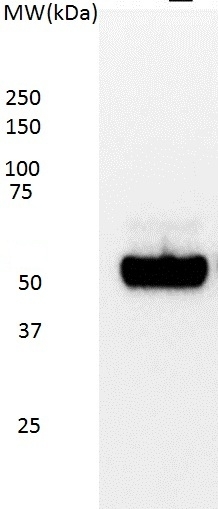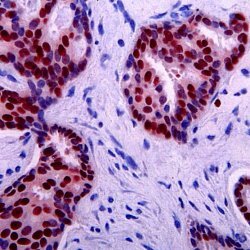p53 antibody | DO-7


Mouse anti p53 (aa20-25)
- Product Type
- Monoclonal Antibody
- Clone
- DO-7
- Isotype
- IgG2b
- Specificity
- p53
- Region
- (aa20-25)
| Mouse anti p53 antibody, clone DO-7 recognizes the human 53 kDa p53 tumour suppressor protein, also known as Cellular tumor antigen p53 or Antigen NY-CO-13, encoded by the TP53 gene. p53 is a 393 amino acid protein with an N-terminal transactivation domain, followed by a proline-rich region and a DNA binding domain in the central core region. The C-terminal region contains a tetramirization domain and a terminal regulatory domain (Joerger et al. 2010). p53 is intimately involved in a number of signaling pathways controlling cell division, cycling and apoptosis (Haupt et al. 2003) and is thus a potent cancer suppressor. In normal cells the level of p53 expression is low but can be induced by DNA damage or other stress signals (Takagi et al. 2005). Activation of p53 leads to growth arrest through its interaction with p21, GADD45 and 14-3-3σ, DNA repair and potentially apoptosis through interaction with Bax, Apaf-1, PUMA and NoxA (Thakur et al. 2010). p53 is critically regulated by Mdm2 which can trigger p53 degradation by a ubiquitin dependent system (Moll and Petrenko 2003) Mouse anti p53 antibody, clone DO-7 recognizes an epitope at the N-terminal end of p53 between amino acids 20-25, binding to both wild type and mutant forms. Clone DO-7 is not expected to recognize the multiple isoforms lacking the N-teminal region. |
- Target Species
- Human
- Species Cross-Reactivity
-
Target Species Cross Reactivity Mouse Rat Bovine - N.B. Antibody reactivity and working conditions may vary between species.
- Product Form
- Purified IgG - liquid
- Preparation
- Purified IgG prepared by affinity chromatography on Protein A from tissue culture supernatant
- Buffer Solution
- Phosphate buffered saline
- Preservative Stabilisers
- 0.09% sodium azide (NaN3)
- Carrier Free
- Yes
- Immunogen
- Recombinant human p53.
- Approx. Protein Concentrations
- IgG concentration 1.0 mg/ml
- Fusion Partners
- Spleen cells from immunized BALB/c mice were fused with cells of the mouse X63Ag8.653 myeloma cell line.
- Regulatory
- For research purposes only
- Guarantee
- 12 months from date of despatch
Avoid repeated freezing and thawing as this may denature the antibody. Storage in frost-free freezers is not recommended.
| Application Name | Verified | Min Dilution | Max Dilution |
|---|---|---|---|
| Flow Cytometry 1 | 1/50 | 1/100 | |
| Immunohistology - Frozen | |||
| Immunohistology - Paraffin 2 | 1/1000 | ||
| Immunoprecipitation | |||
| Western Blotting | 1/1000 |
- 1 Membrane permeabilization is required for this application. The use of Leucoperm (Product Code BUF09) is recommended for this purpose.
- 2This product requires antigen retrieval using heat treatment prior to staining of paraffin sections.Sodium citrate buffer pH 6.0 is recommended for this purpose.
- Flow Cytometry
- Use 10μl of the suggested working dilution to label 1x106 cells in 100μl
- Histology Positive Control Tissue
- Normal human colon or breast carcinoma
| Description | Product Code | Applications | Pack Size | List Price | Your Price | Quantity | |
|---|---|---|---|---|---|---|---|
| Mouse IgG2b Negative Control | MCA691 | F | 100 Tests |
|
Log in | ||
| List Price | Your Price | ||||||
|
|
Log in | ||||||
| Description | Mouse IgG2b Negative Control | ||||||
References for p53 antibody
-
Vojtěsek, B. et al. (1992) An immunochemical analysis of the human nuclear phosphoprotein p53. New monoclonal antibodies and epitope mapping using recombinant p53.
J Immunol Methods. 151 (1-2): 237-44. -
Xinarianos, G. et al. (2002) p53 status correlates with the differential expression of the DNA mismatch repair protein MSH2 in non-small cell lung carcinoma.
Int J Cancer. 101: 248-52. -
Iannone, F. et al. (2005) Increased Bcl-2/p53 ratio in human osteoarthritic cartilage: a possible role in regulation of chondrocyte metabolism.
Ann Rheum Dis. 64: 217-21. -
Lin, L.C. et al. (2006) p53 and p27 as predictors of clinical outcome for rectal-cancer patients receiving neoadjuvant therapy.
Surg Oncol. 15: 211-6. -
Huang, H.Y. et al. (2008) Immunohistochemical and biogenetic features of diffuse-type tenosynovial giant cell tumors: the potential roles of cyclin A, P53, and deletion of 15q in sarcomatous transformation.
Clin Cancer Res. 14: 6023-32.
MCA1703
If you cannot find the batch/lot you are looking for please contact our technical support team for assistance.
Please Note: All Products are "FOR RESEARCH PURPOSES ONLY"
View all Anti-Human ProductsAlways be the first to know.
When we launch new products and resources to help you achieve more in the lab.
Yes, sign me up
